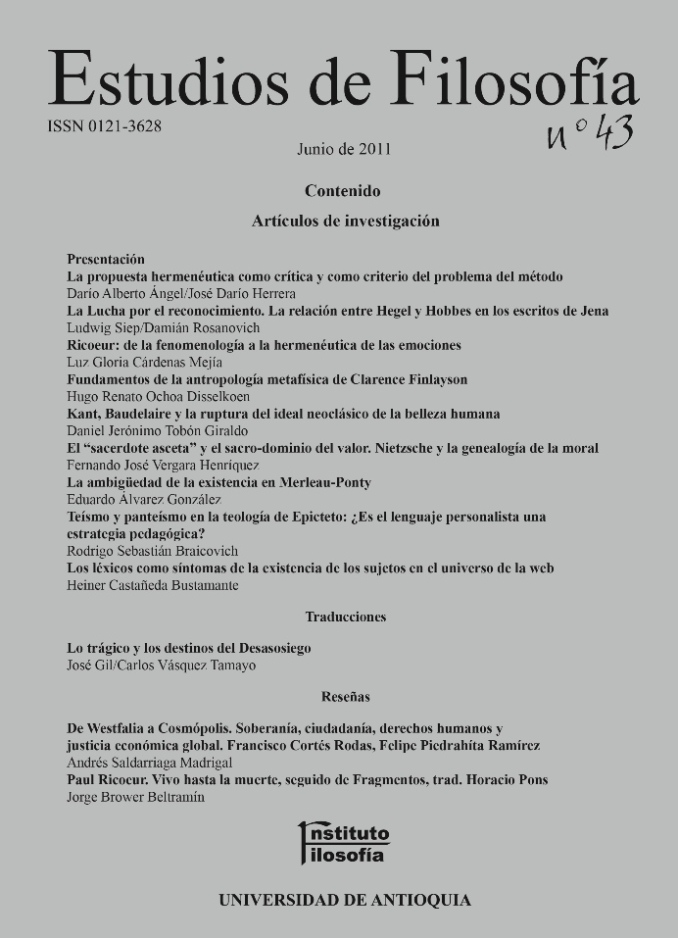Kant, Baudelaire and the breakup of the Neoclassical ideal of human beauty
DOI:
https://doi.org/10.17533/udea.ef.11571Keywords:
Kant, Baudelaire, idealbeauty, modernity, classicism, human beauty, aestheticsAbstract
In the realm of Contemporary Visual Arts, there hovers over Human Beauty a tacit ban. The Human Body is still one of the central themes of Art, but it is not in the habit of being represented as beautiful: emphasis is laid on its ugliness, or in the terrible or abject aspects of Corporality. This paper tries to understand the process that led to this situation starting from the transformation of the concept of “Ideal Beauty” between Kant and Baudelaire, which shows a deep connection between the concept of Human Beauty and the hope for Moral Progress. We maintain that the break-up of this hope is one of the reasons why Modern and Contemporary Art have rejected so forcefully the representation of Ideal Beauty.
Downloads
References
ASSUNTO, R. (1989) Acerca de la austeridad de la «belleza» kantiana (belleza sin gracia), En: Naturaleza y razón en la estética del setecientos, Madrid, Visor, pp, 71—115.
BAUDELAIRE, C. (1989) Edgar Allan Poe, Trad. de C. Santos, Madrid, Visor.
BAUDELAIRE, C. (1996) Salones y otros escritos sobre arte, Trad. de C. Santos, Madrid, Visor.
BAUDELAIRE, C. (1999a) Diarios íntimos, Trad. de J. P. Díaz, Buenos Aires, Leviatán.
BAUDELAIRE, C. (1999b) Crítica literaria, Trad. de L. Vásquez, Madrid, Visor.
BAUDELAIRE, C. (2003) Obra poética completa: texto bilingüe, Trad. de E. López Castellón, Madrid, Ediciones Akal.
BELTING, H. (2007) La imagen del cuerpo como imagen del ser humano, Una representación en crisis, En: Antropología de la imagen, Buenos Aires, Katz Editores, pp. 109—141. DOI: https://doi.org/10.2307/j.ctvm7bcgx.7
BÜRGER, P. (1987) Teoría de la vanguardia, Trad. de J. García, Barcelona, Ediciones Península.
CARROLL, N. (2005) Filosofía del terror o paradojas del corazón, Trad. de G. Vilar, Madrid, Antonio Machado Libros.
DANTO, A. C. (2003) The Abuse of Beauty: Aesthetics and the Concept of Art, Chicago Ill., Open Court.
GOETHE, J. (1999a) Esbozos para una semblanza de Winckelmann, En: Escritos de arte, Trad. de M. Salmerón, Madrid, Ed, Síntesis, pp. 183—219.
GOETHE, J. (1999b) Introducción a Los propíleos, En: Escritos de arte, Trad. de M. Salmerón, Madrid, Ed, Síntesis, pp. 89—106.
GUYER, P. (1996) Feeling and Freedom, En: Kant and the Experience of Freedom: Essays on Aesthetics and Morality, New York, Cambridge University Press, pp. 27—47.
G. W. F. (1989) Lecciones sobre la estética, Trad. de A. Brotóns Muñoz, Madrid, Akal.
KANT, I. (1991) Antropología en sentido pragmático, Madrid, Alianza Editorial.
KANT, I. (1993) La metafísica de las costumbres, Trad de A. Cortina Orts & J. Connil Sancho, Barcelona, Altaya.
KANT, I, (1994), Idea de una historia universal en sentido cosmopolita, En: Filosofía de la historia, trad. de E. Imaz, Bogotá, Fondo de Cultura Económica, pp. 39—65.
KANT, I. (2007), Crítica del juicio, Trad. de M. García Morente, Madrid, Tecnos.
DE MICHELI, M. (1983), Las vanguardias artísticas del siglo XX, Trad. de Á. Sánchez Gijón, Madrid, Alianza Editorial.
RAMÍREZ, J. A. (2003) Corpus Solus, Madrid, Siruela.
TONELLI, G. (1973) Ideal in Philosophy from the Renaissance to 1780, En: Dictionary of the History of Ideas, New York, Scribners, Vol. II, pp. 549—552. DOI: https://doi.org/10.1353/hph.2008.0222
WILDE, O. (1982) El retrato de Dorian Gray, Trad. de J. Gómez de la Serna, Bogotá, La Oveja Negra.
WINCKELMANN, J. (1987) Reflexiones sobre la imitación del arte griego en la pintura y la escultura, Trad. de V. Jarque, Barcelona, Península.
Downloads
Published
How to Cite
Issue
Section
Categories
License
Copyright (c) 2011 Daniel Jerónimo Tobón Giraldo

This work is licensed under a Creative Commons Attribution-NonCommercial-ShareAlike 4.0 International License.
Authors who publish with this journal agree to the following terms:
1. The Author retains copyright in the Work, where the term "Work" shall include all digital objects that may result in subsequent electronic publication or distribution.
2. Upon acceptance of the Work, the author shall grant to the Publisher the right of first publication of the Work.
3. The Author shall grant to the Publisher a nonexclusive perpetual right and license to publish, archive, and make accessible the Work in whole or in part in all forms of media now or hereafter known under a Creative Commons Attribution-NoCommercia-ShareAlike (CC BY-NC-SA 4.0), or its equivalent, which, for the avoidance of doubt, allows others to copy, distribute, and transmit the Work under the following conditions: (a) Attribution: Other users must attribute the Work in the manner specified by the author as indicated on the journal Web site;(b) Noncommercial: Other users (including Publisher) may not use this Work for commercial purposes;
4. The Author is able to enter into separate, additional contractual arrangements for the nonexclusive distribution of the journal's published version of the Work (e.g., post it to an institutional repository or publish it in a book), as long as there is provided in the document an acknowledgement of its initial publication in this journal;
5. Authors are permitted, and Estudios de Filosofía promotes, to post online the preprint manuscript of the Work in institutional repositories or on their Websites prior to and during the submission process, as it can lead to productive exchanges, as well as earlier and greater citation of published work (see The Effect of Open Access). Any such posting made before acceptance and publication of the Work is expected be updated upon publication to include a reference to the Estudios de Filosofía's assigned URL to the Article and its final published version in Estudios de Filosofía.















